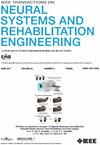一种新的自适应推进增强体验(APEX)系统:用于增强中风幸存者步态推进的开发和初步验证
IF 4.8
2区 医学
Q2 ENGINEERING, BIOMEDICAL
IEEE Transactions on Neural Systems and Rehabilitation Engineering
Pub Date : 2025-04-14
DOI:10.1109/TNSRE.2025.3560324
引用次数: 0
摘要
本研究介绍了一种名为APEX (Adaptive Propulsion Enhancement eXperience)的新系统的开发和初步验证,该系统旨在增强中风幸存者的步态推进力。APEX系统采用双带式仪器跑步机,能够实时测量地面反作用力和调节皮带速度,提供动态推进的视觉生物反馈。我们开发了两种推进模式:推进促进模式和推进增强模式,前者通过延长与地面的接触时间来激发内在的推进力,后者通过施加可控的外力来增加推进力。10名慢性中风幸存者(7名女性和3名男性;年龄:$61.40~ $ pm ~ $ 6.96$ years)完成了推进促进模式和推进增强模式两项实验。每个试验包括30步无辅助的基线期(视觉生物反馈和推进力提升),100步有辅助的训练期,30步无辅助的训练后期。在每个时期,结果测量(推进力、冲量、下肢运动学和肌肉活动)被量化。统计分析显示,与基线期相比,在训练和训练后期间,推进力、冲量、下肢运动学和肌肉活动都有显著改善,而训练和训练后期间没有显著差异。这些发现证明了APEX系统在提供实时、自适应训练以增强步态推进方面的有效性和可靠性。将APEX系统整合到临床实践中,有可能为中风后的步态康复提供可扩展的、针对患者的方法。本文章由计算机程序翻译,如有差异,请以英文原文为准。
A Novel Adaptive Propulsion Enhancement eXperience (APEX) System: Development and Preliminary Validation for Enhancing Gait Propulsion in Stroke Survivors
This study presents the development and preliminary validation of a novel system, called APEX (Adaptive Propulsion Enhancement eXperience), which aims to enhance gait propulsion in stroke survivors. The APEX system utilizes a dual-belt instrumented treadmill capable of measuring ground reaction forces and modulating belt speed in real time to provide visual biofeedback with dynamic propulsion promotion. We developed two propulsion promotion modes: the propulsion-facilitating mode, which extends ground contact time to elicit intrinsic propulsive effort and the propulsion-augmenting mode, which increases propulsive force by applying controlled external force. Ten chronic-stage stroke survivors (7 females and 3 males; age: $61.40~\pm ~6.96$ years) completed two experimental trials: one with the propulsion-facilitating mode, and the other with the propulsion-augmenting mode. Each trial included a baseline period without assistance (visual biofeedback and propulsion promotion) for 30 steps, a training period with assistance for 100 steps, and a post-training period without assistance for 30 steps. For each period, outcome measures (propulsive force, impulse, lower-limb kinematics, and muscle activity) were quantified. Statistical analysis revealed significant improvements in propulsive force, impulse, lower-limb kinematics, and muscle activity during both the training and post-training periods compared to the baseline period, with no significant differences between the training and post-training periods. These findings demonstrate the efficacy and reliability of the APEX system in delivering real-time, adaptive training to enhance gait propulsion. Integrating the APEX system into clinical practice has the potential to provide a scalable, patient-specific approach for post-stroke gait rehabilitation.
求助全文
通过发布文献求助,成功后即可免费获取论文全文。
去求助
来源期刊
CiteScore
8.60
自引率
8.20%
发文量
479
审稿时长
6-12 weeks
期刊介绍:
Rehabilitative and neural aspects of biomedical engineering, including functional electrical stimulation, acoustic dynamics, human performance measurement and analysis, nerve stimulation, electromyography, motor control and stimulation; and hardware and software applications for rehabilitation engineering and assistive devices.

 求助内容:
求助内容: 应助结果提醒方式:
应助结果提醒方式:


